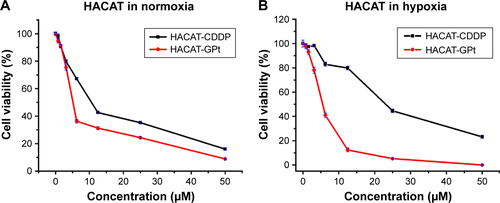Abstract
Background
Tumor microenvironment plays an important role in the chemoresistance of oral squamous cell carcinoma (OSCC). Hypoxia in the microenvironment is one of the important factors that contributes to OSCC chemoresistance; therefore overcoming hypoxia-mediated chemoresistance is one of the great challenges in clinical practice.
Methods
In this study, we developed a drug delivery system based on Pt-loaded, polyethylene glycol-modified graphene quantum dots via chemical oxidation and covalent reaction.
Results
Our results show that synthesized polyethylene glycol-graphene quantum dots-Pt (GPt) is about 5 nm in diameter. GPt sensitizes OSCC cells to its treatment in both normoxia and hypoxia conditions. Inductively coupled plasma-mass spectrometry assay shows that GPt enhances Pt accumulation in cells, which leads to a notable increase of S phase cell cycle arrest and apoptosis of OSCC cells in both normoxia and hypoxic conditions. Finally, compared with free cisplatin, GPt exhibits a strong inhibitory effect on the tumor growth with less systemic drug toxicity in an OSCC xenograft mouse tumor model.
Conclusion
Taken together, our results show that GPt demonstrates superiority in combating hypoxia-induced chemoresistance. It might serve as a novel strategy for future microenvironment-targeted cancer therapy.
Introduction
Despite rapid advances in therapeutic technologies and extensive research, the 5-year survival rate of oral squamous cell carcinoma (OSCC) has not improved in recent years and remains at 40%–60%.Citation1,Citation2 Chemotherapy is an alternative choice for patients with lymph node metastasis or tumor relapse after surgery.Citation3 According to the treatment protocols for OSCC, cisplatin (cisdiamminedichloroplatinum (II) [CDDP])-based chemotherapeutic regimens are the first-line drugs recommended for OSCC patients. Theoretically, CDDP is able to bind with cell DNA, which could later lead to cell cycle arrest and finally cell death.Citation4 However, many OSCC patients do not respond to conventional chemotherapy well due to drug resistance. In addition, the therapeutic performance of CDDP is also strongly affected by its poor solubility, systemic toxicity, and drug resistance.Citation5 Thus, new strategies to overcome the drawbacks of free CDDP in chemotherapy are urgently needed.
Table S1 Nano-size properties of GQDs and GPt
Table S2 The cell cycle of HSC3 cells after treatment
Table S3 Pt accumulated inside cells in normoxia and hypoxia
Chemoresistance is mediated by multiple factors, such as abnormal uptake and metabolism of drugs, drug inactivation, and phenotype changes of tumor cells, etc.Citation6 Recently, many studies have shown that tumor microenvironment plays a pivotal role in the development of chemoresistance.Citation7 Hypoxia around tumor cells is widely regarded as a prominent factor of this microenvironment.Citation8,Citation9 To date, accumulating evidence suggests that tumor hypoxia contributes greatly to chemoresistance.Citation10 In accordance with previous reports, our group has also demonstrated that tumor hypoxia promotes OSCC resistance to the treatment of CDDP, with hypoxia inducible factor-1α (HIF-1α) acting as a key mediator.Citation11,Citation12 Tumor microenvironment is a double-edged sword, because facts have proved that these special endogenous properties inside the tumor can be applied to trigger the release of cancer therapeutics.Citation13 Vascular abnormalities and tumor metabolic activity seek increased glycolysis. Increased glycolysis leads to decreased pH and the pH could decline to 5.Citation14 Currently, several studies have demonstrated that the acidic condition in the tumor site is a promising means of eliciting drug release.Citation15–Citation18 And, in our work, we found that drug molecules of Pt were preferentially released from the nanodrug in acidic conditions compared with the normal physical condition.
Currently, considerable efforts have been made to develop advanced drug delivery systems, aiming to improve the efficacy and reduce the side effects of chemotherapy.Citation19,Citation20 Recent studies have demonstrated that graphene quantum dots (GQDs) might be an ideal candidate.Citation21–Citation23 Different from conventional nano-sized drug platforms, GQDs exhibit extraordinary drug loading capacity via strong π–π stacking interactions and functional modification.Citation21 Notably, functionalized GQDs are assumed to have a single atomic layer and dimensions >20 nm.Citation24,Citation25 Even with the loading of traditional anticancer drugs, such as CDDP, they can still be prepared in nano-sizes, enabling them to easily pass through the nuclear pore complex and reside within the cells, and that might help combat hypoxia-induced drug efflux and chemoresistance. Moreover, GQDs are made from carbon ensuring good water solubility, extraordinary biocompatibility, minimal toxicity, and stable fluorescence.Citation21,Citation23,Citation26,Citation27
In this study, we developed a tumor-targeted polyethylene glycol-graphene quantum dots-Pt (GPt) nanocomposite, based on polyethylene glycol (PEG)-modified GQDs to carry Pt. It was demonstrated that GPt could dramatically improve the chemotherapeutic efficacy for OSCC in vitro and in vivo, which might serve as a useful method for future tumor-targeted treatment.
Materials and methods
Materials and agents
Cis-Pt(NH3)2Cl2 (purity >98%), 4arm-PEG-Amine, 1-ethyl-3-[3-dimethylaminopropyl]carbodiimide hydrochloride (EDC), N-hydroxysuccinimide (NHS), O-phenylenediamine (OPDA), and dimethylformamide (DMF) were purchased from Sigma-Aldrich Co (St Louis, MO, USA). OPDA was used as an adjuvant to detect the existence form of CDDP. CX-72 carbon black was purchased from Cabot Corporation, Boston, MA, USA. Other reagents were obtained from Adamas-beta, Shanghai, China and Sigma-Aldrich Co. All solutions were prepared with ultrapure water (18.2 MU⋅cm) from a Millipore system (Millipore SAS, Molsheim, France). Dulbecco’s Modified Eagle’s Medium (DMEM, high glucose) and phosphate-buffered saline (PBS) were purchased from HyClone (GE Healthcare Life Sciences, Little Chalfont, UK). Fetal bovine serum (FBS) was purchased from Biological Industries Israel Beit-Haemek, Kibbutz Beit-Haemek, Israel. Annexin V-fluorescein isothiocyanate, an apoptosis detection kit (Vazyme Biotech Co, Ltd, Nanjing, China). A cell counting kit (CCK-8) was obtained from Sigma-Aldrich Co. Cell cycle analysis kit was purchased from KeyGene Inc (Nanjing, China). Hypoxia environment in the patient-derived tongue tumor xenograft (PDX) model was detected with Hypoxyprobe™-1 Plus Kit and the probe was purchased from Hypoxyprobe Inc (Burlington, MA, USA).
Preparation of graphene oxide (GO) quantum dots
GQDs were prepared following the method reported by Dong et al.Citation28 Briefly, 0.2 g dried CX-72 carbon black was added to 50 mL HNO3 (6 M). The product was centrifuged (2,770× g) for 10 minutes to separate the supernatant and sediment. The sediment was washed with 1 M HCl and centrifuged (2,770× g) three times, and subsequently was dried under vacuum. Then, the dried sample was placed in 50 mL H2O, and thereafter the solution was adjusted to a pH of about 8 with 10 mM ammonia water. Dialysis was performed for 24 hours with a 100 kDa molecular weight cutoff membrane (Amicon Ultra-4; Merck Millipore, Billerica, MA, USA). Then, the supernatants were collected and freeze-dried to obtain GQDs.
Synthesis and characterization of GQDs-COOH, Pt-GQDs-COOH, and PEG-GQDs-Pt (GPt)
The surfaces of GQDs exhibit hydroxyl (OH), epoxy, and carboxyl (COOH) groups. To convert the OH and epoxy groups to COOH groups, 1.2 g NaOH and 1.0 g ClCH2COOH were added to 10 mL of aqueous GQDs solution (2 mg/mL), and the mixture was sonicated for 3 hours at room temperature to obtain GQDs-COOH. The product, GQDs-COOH, was neutralized with HCl and filtered and rinsed with distilled water at least three times.Citation29 CDDP was loaded onto the GQDs-COOH by forming a covalent bond.Citation30 To identify the best reaction ratio between CDDP and GQDs-COOH, CDDP (10 μM in 10−4 M hydrochloric acid) was added into GQDs-COOH suspensions at different concentrations. The mixture was bath-sonicated for 30 minutes and then stirred overnight at room temperature. EDC (12 mg) and NHS (18 mg) were added to the 5 mL Pt-GQDs-COOH suspension at pH 5.6, and the mixture was sonicated for 15 minutes.Citation23 4arm PEG-NH2 (50 mg) was then added to the above suspension and stirred overnight at room temperature.Citation23,Citation29 The resultant solution was dispersed in 30 mL distilled water and immersed in a dialysis bag (molecular weight, 10,000 MD) to remove free substrates. Finally, the solution was dried with lyophilization to obtain GPt. To verify that CDDP had been attached to the GQDs, we used the method reported by Anilanmert et al and Raghavan and Mulligan.Citation31,Citation32 The product of CDDP interacting with OPDA can exhibit an ultraviolet (UV) absorption peak at 705 nm based on the ligand-exchange reaction between CDDP and OPDA, thus producing a new complex with a maximum absorbance at 705 nm.Citation32 OPDA (14 mg) was dissolved in 10 mL DMF to prepare an OPDA stock solution. A suspension of GPt (100 μL) was added into 100 μL OPDA stock solution, and the mixture was heated for 30 minutes at 90°C. After cooling to room temperature, a mixture of DMF/water (7/3, v/v) was added to a total volume of 1 mL. The absorbance of the product was monitored at 705 nm. The GPt obtained was dissolved in distilled water for further experiments and atomic absorption spectrometry (AAS) was utilized to examine the Pt in the GPt solution.
UV–visible absorption spectra of GQDs, Pt-GQDs-COOH, and GPt in the spectral range of 200–500 nm were recorded by a UV-3600 UV–vis spectrophotometer (Shimadzu Corporation, Kyoto, Japan). Emission spectra were recorded by using an F-4600 spectrofluorophotometer (Hitachi Ltd, Tokyo, Japan). Both examinations were conducted with a 2-nm slit width at a scan speed of 200 nm/min. Transmission electron microscopy (TEM) and atomic force microscopy (AFM) were used to characterize the sizes of the GQDs and GPt. Diameter statics analysis was conducted by Nano Measurer 1.2 software (Jie Xu, Fudan University, Shanghai, China). Later on, dynamic light scattering (DLS; NanoPlus particle size analyzer; Brookhaven Instruments Corporation, Holtsville, NY, USA) was also utilized to detect the particle size of GQDs and GPt. In addition, the NanoPlus particle size analyzer was also utilized to detect the zeta potential of GQDs and GPt.
Pt release
The pH-responsive Pt-release behavior was observed using inductively coupled plasma-mass spectrometry (ICP-MS). Pt released from the GQDs was detected at pH 5.0 as follows: 5 mL of GPt was transfused into a dialysis bag (molecular weight: 10000 Da), and the bag was immersed in 30 mL of acetate buffer (pH 5) at room temperature. At each time point, the outer dialysate was collected and replaced with fresh acetate buffer. Pt released at pH 7.4 was evaluated using the same procedure except that the dialysate buffer was changed to PBS (pH 7.4). CDDP solutions with five concentrations served as standard samples.
Cell lines and cell culture
OSCC cell lines (HSC3, SCC4, and CAL-27) were obtained from the Cell Bank of the Chinese Academy of Sciences (Shanghai, China). Cells were cultured in a monolayer in DMEM supplemented with 10% FBS, 100 μg/mL streptomycin, and 100 U/mL penicillin in a humidified incubator (5% CO2/20% O2, normoxia or 5% CO2/1% O2, hypoxia) at 37°C. Confluent cells were trypsinized with 0.05% trypsin containing 0.02% ethylenediaminetetraacetic acid.
Cytotoxicity assay
The toxicities of CDDP, GQDs, PEG, and GPt were tested using CCK-8 kits. Cells were plated in 96-well plates at densities of 5,500–6,500 cells in 100 μL complete culture medium. Blank control wells containing the same volume of complete culture medium were included in each assay. The microplate was incubated for 3–5 hours at 37°C until cells adhered to the plates. The cells were then washed with PBS buffer and incubated with CDDP, GQDs, PEG, and GPt, which were serially diluted in the complete culture medium before use. The plate was incubated for a further 24–36 hours. CCK-8 (10 μL) was added to each well. The optical density (OD) of formazan at 450 nm was recorded every 0.5 hour until the OD was 1.0–2.0. Six wells corresponded to each concentration of the above drugs. Cell viability was calculated as follows: cell viability = ([OD]test − [OD]control)/([OD]control − [OD]blank) ×100%.
Measurement of Pt inside cells
The cell suspension was further lysed by sonication on an ultrasonic processor for 10 seconds at 20% amplitude. A portion of the lysate (750 μL) was then combined with 750 μL of a 2% HNO3 (v/v) solution, and the remainder of the lysate was quantified for protein concentration by bicinchoninic acid (BCA) assay. The 1% HNO3 solution was analyzed for Pt content using a PerkinElmer NexION 300x ICP-MS instrument (PerkinElmer Inc, Waltham, MA, USA). Pt counts were normalized to the amount of protein determined from the BCA analysis (to obtain [Pt]/[protein]). Every experiment was repeated three times.
Cell cycle analysis
Flow cytometry was used to detect the cell cycle using cell cycle kits. HSC3 cells were fixed with 70% cooled ethanol for 2 hours at 4°C and then washed three times with PBS. After treatment with RNase for 15 minutes at 37°C, 50 μg/mL propidium iodide (PI) was added to the cells followed by incubation for 15 minutes in the dark. Samples were detected with a FACSVerse flow cytometer (BD Biosciences, San Jose, CA, USA) and the data obtained were analyzed by FlowJo (FlowJo LLC, Ashland, OR, USA).
Apoptosis detection
Cells (HSC3 and SCC4) were incubated with CDDP, GQDs, PEG, and GPt or without any treatment. The concentration of Pt was the mean of the half maximal inhibitory concentration (IC50) values of CDDP and GPt. These cells were cultured in six-well plates. Apoptotic cells were quantified by dual staining with Annexin V and PI. After washing with PBS, the cells were suspended in cold binding buffer. Annexin V (5 μL) and 100 μL PBS were added into each well for 10 minutes at 4°C. Subsequently, 200 μL binding buffer containing 5 μL PI was added. Finally, the entire mixture was incubated at 4°C for another 15 minutes. All the incubation was performed in the dark. Samples were detected with a FACSVerse flow cytometer (BD Biosciences) and the data obtained were analyzed by FlowJo.
Measurement of GPt distribution in cells
Images were taken using a Nikon ECLIPSE Ti-S microscope (Nikon Corporation, Tokyo, Japan). HSC3 cells were cultured with GPt and Pt-GQD-COOH for 2, 5, 8, and 24 hours, respectively. The cell membrane was stained with 1,1′-Dioctadecyl-3,3,3′,3′-tetramethylindocarbocyanine perchlorate (Dil) in red. Pt-GQDs-COOH was used as the control.
Measurement of anticancer effect of GPt in xenograft tumor mouse model in vivo
Tumors were transplanted in BALB/cJNJu-Foxn1nu/Nju (4 weeks old) male mice via a hypodermic injection of 1×106 HSC3 cells suspended in 100 μL PBS solution in each mouse. Each tumor was measured with calipers, and its volume VT was calculated as V = L* W*W/2. Chemotherapy began when VT reached ~100 mm3. Mice were randomly stratified into four experimental groups (n=5/group), which received the following treatments via tail vein injection: group A, PBS (100 μL); group B, CDDP (concentration of Pt 5 mg/kg; 100 μL); group C, GQDs (200 μg/mL; 100 μL), and group D, GPt (concentration of Pt 5 mg/kg; 100 μL). Treatments were repeated every 3 days for a total of 15 days. Mice were monitored daily for tumor growth (using digital calipers), cachexia, and weight loss. Finally, the mice were sacrificed by cervical dislocation under anesthesia.
Histopathological analysis and immunohistochemistry (IHC)
The major organs including heart, liver, kidney, and tumors were dissected and fixed in paraformaldehyde (PFA; 4%). Then, these tissues were dehydrated, embedded in paraffin, and stained with hematoxylin and eosin. Histologies were examined by a microscope (Olympus Corporation, Tokyo, Japan). Tumor sections counterstained with hematoxylin for nuclear coloration were observed using the microscope. The expression of HIF-1α in neoplastic tissues was detected to investigate the hypoxia environment in tumor sections before and after treatment. Apoptosis in the tumor specimens from mice was performed by the terminal deoxynucleotidyl transferase-mediated dUTP-biotin nick end labeling assay (TUNEL) assay using an in situ cell death kit (Hoffman-La Roche Ltd, Basel, Switzerland) according to the manufacturer’s protocol. The expression of HIF-1α and TUNEL in tumor tissues was detected by IHC. After treatment with the different formulations, tumor tissues were excised and fixed in 4% PFA until further use. The samples were rehydrated through a graded alcohol series before embedding with paraffin. The expression of HIF-1α proteins in these tissues was evaluated using biotinylated rabbit anti-human HIF-1α antibodies (Abcam, Cambridge, UK; ab216842).
Measurement of distribution of Pt inside tissues
ICP-MS (NexION 350D; PerkinElmer Inc) was used to detect the distribution of Pt inside major organs and tumors. Tumors and major organs were dissected from the mice after cervical dislocation and weighed. For ICP-MS analysis, solutions with five concentrations of CDDP (500, 50, 5, 0.5, and 0.05 ng/mL) were configured as standard samples. Tissue homogenate was digested with nitric acid for 20 minutes and then sonicated for 10 minutes. After all digests were centrifuged at 12,000 rpm for 10 minutes, 0.5 mL of supernatant was removed and diluted to 1 mL with redistilled water for analysis by ICP-MS. The amount of Pt was calculated using the standard samples.
Statistical analysis
All data were expressed as mean ± standard deviation. Statistical differences were measured using an unpaired two-sided Student’s t-test or one-way analysis of variance for multiple comparisons when appropriate. A p-value <0.05 was considered as a statistically significant difference. SPSS (SPSS Inc, Chicago, IL, USA), GraphPad (GraphPad Software Inc, La Jolla, CA, USA), and Origin (OriginLab Corporation, Northampton, MA, USA) software were used for the statistical analysis. Nano Measurer 1.2 was used to analyze the size of nanodrugs. Every experiment was repeated at least three times.
Ethics statement
Institutional review board approval was obtained from Nanjing Stomatological Hospital Ethics Committee (approval number, 2016NL-016[KS]). All animal experiments and experimental protocols were in accordance with the Animal Care and Use Committee of the Medical School of Nanjing University.
Results
Preparation and characterization of GQDs, GQDs-Pt, and GPt
The preparation process of GPt is illustrated in . Materials were characterized by UV absorption, fluorescence emission, DLS, TEM, and AFM. UV−visible spectroscopy showed that the absorbance of GQDs ranged from 200 to 350 nm; however, there was an obvious extra small peak between 250 and 300 nm after Pt was loaded onto the GQDs (). GPt could be excited at 200 and 405 nm (). Intriguingly, strong emission could also be observed at 405 nm (). The interaction between GQDs and CDDP was verified by the decrease in UV–visible absorbance at 705 nm (). The UV–visible spectra of CDDP and OPDA in the presence of different concentrations of GQDs are shown in . No interaction was observed between GQDs and OPDA (, purple line). The strongest absorbance was exhibited by the complex formed by OPDA and free CDDP (, black line). However, the absorbance at 705 nm declined upon the addition of GQDs. Among all the tested GQDs-COOH concentrations, the addition of 200 μg/mL GQDs-COOH produced the lowest absorbance, indicating that CDDP had almost completely reacted with the GQDs-COOH. Considering no interaction occurred between GQDs-COOH and OPDA, the reduction in intensity at 705 nm was clearly caused by the interaction between GQDs and CDDP. Therefore, we used a 200 μg/mL/0.5 mM ratio of GQDs-COOH to CDDP in the following experiments. The GPt obtained was dissolved in distilled water for further experiments. AAS was utilized to examine the Pt in the GPt solution. Pt in the final GPt suspension was measured as 64.00 mg/L. So, the productive rate of Pt in the whole synthesis was 42% (productive rate = [64/300.05]/0.5×100%).
Figure 1 Schematic illustration of a multifunctional platform for anticancer therapy with high efficacy against hypoxia-induced chemoresistance of OSCC. We firstly demonstrated that the hypoxia microenvironment permeated throughout the tongue squamous cancer patient-derived tumor model. Then, a multifunctional nanodrug GPt can serve as an ideal candidate for anticancer therapy by improving pharmacokinetics of the drug for greater tumor accumulation through EPR effect and minimizing systemic toxicity.
Abbreviations: OSCC, oral squamous cell carcinoma; EPR, enhanced permeability and retention; CDDP, cisdiamminedichloroplatinum (II); PDX, patient-derived tongue tumor xenograft; GQD, graphene quantum dot; PEG, polyethylene glycol; EDC, N-(3-dimethylaminopropyl-N0-ethylcarbodiimide) hydrochloride; NHS, N-hydroxysuccinimide; GPt, PEG-GQDs-Pt.
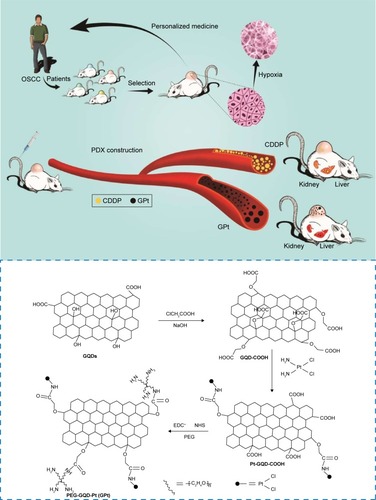
Figure 2 Characterization of GQDs and GPt. (A) The absorbance of GQDs (2 mg/mL, red) and GPt (10 μM, black) in double distilled water (pH =7.4). (B) Fluorescence emission spectra of GQDs (2 mg/mL, red) and GPt (10 μM, black). (C) Interaction of GPt and OPDA. The product of CDDP and OPDA gives the strongest absorbance at 705 nm (black). (D) The average size of GQDs and GPt measured by DLS. TEM and AFM images of (E and F) GQDs and (G–J) GPt. (K) Statistics analyzed by Nano Measurer 1.2; the sizes of GQDs and GPt were 2.35±0.44 and 5.23±0.66 nm. Unpaired Student’s t-test was performed to compare the sizes of GQDs and GPt; significant difference between the sizes of GQDs and GPt could be clearly seen with p-value <0.0001. ****p<0.0001.
Abbreviations: CDDP, cisdiamminedichloroplatinum (II); GQDs, graphene quantum dots; PEG, polyethylene glycol; DLS, dynamic light scattering; TEM, transmission electron microscopy; AFM, atomic force microscopy; OPDA, O-phenylenediamine; GPt, PEG-GQDs-Pt.
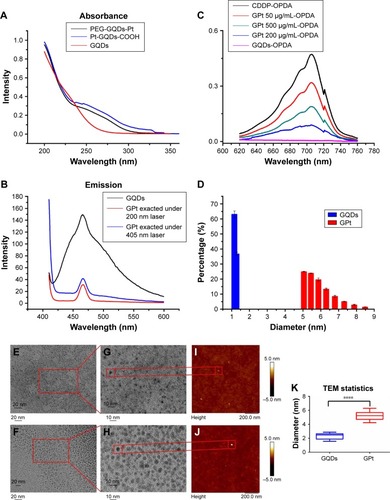
The average sizes of GQDs and GPt were 1.35 and 5.72 nm, respectively, as measured by DLS (). Detailed information is provided in . The TEM and AFM images showed that GQDs and GPt were well dispersed with a uniform lateral size (). Nano Measurer 1.2 was used to analyze the result of TEM of nanodrugs. As shown in , the average size of GQDs was 2.35±0.44 nm and the average size of GPt was 5.23±0.66 nm which was similar to the result obtained by DLS (). Thus, the binding of PEG and Pt to the GQDs increased the diameter of the GQDs by ~2.88–4.37 nm. Zeta potential measurements were evaluated by NanoPlus and the result indicated that GQDs and GQDs-COOH acquired negative surface charge: −13.95±5.66 mV for GQDs () and −15.57±6.08 mV for GQDs-COOH (). Four-armed PEG-NH2 could reverse the negative charge to positive surface charge, +9.61±3.82 mV (). The positive potential of GPt on one hand could avoid GQD aggregation and on the other hand could enhance cellular uptake.
pH-dependent release of Pt
The initial concentration of Pt in the final GPt suspension in PBS was measured as 64 mg/L. The pH-triggered release of Pt from GPt was calculated by AAS. Pt release was evaluated in acidic environments (pH =5.0) at eight different time points, which is a key feature of the environment both around tumor cells and within tumor cells, especially in lysosomes. The released Pt was filtrated at the defined time intervals and assayed by AAS (). It was demonstrated that there was much more Pt released at lower pH. Nearly 80% and 84.41% of Pt was released in 24 and 48 hours, respectively, at pH 5.0, which was nearly two-fold more than the amount released at pH 7.4 (). This pH-sensitive Pt-release behavior is very important for “smart” drug carriers since many pathological environments in tumor tissues, intracellular lysosomes, and endosomes have a lower pH than in normal tissues and cells.Citation16,Citation33 To improve the stability of GQDs in physiological solution, GQDs were sonicated into smaller pieces. Four-armed PEG-amine was conjugated to the carboxylic acid groups on GQDs-Pt via amide formation.Citation29,Citation34 As seen in , GPt exhibited remarkable stability in all biological solutions, including stroke-physiological saline solution, PBS, and DMEM (), while nano GO existed as a mass of sediment in these solutions as shown in . On one hand, GPt can be triggered in acidic condition at a pH of 5. On the other hand, GPt nanodrug can still keep stable with clean solution without visual sediment, which is superior to GO, as GO would tend to aggregate in sediment ().
Figure 3 Acid triggers Pt release and improves the stability of GPt in physiological solutions. (A) Pt release in acid and neutral environments. The results are the mean ± SD from three independent experiments. **p<0.01. (B) GPt in normal saline, PBS, and DMEM (from left to right); (C) GO in normal saline, PBS, and DMEM (from left to right) as shown by a mass sediment in transparent solutions.
Abbreviations: PBS, phosphate-buffered saline; DMEM, Dulbecco’s Modified Eagle’s Medium; GO, graphene oxide; GPt, polyethylene glycol-graphene quantum dots-Pt.
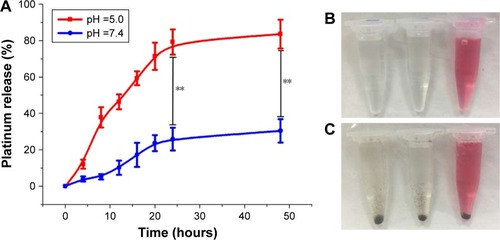
In vitro antitumor effect of GPt in normoxia condition
CDDP, which has the ability to inhibit cell proliferation, serves as a first-line medicine for the treatment of testicular and ovarian cancers along with cervical, bladder, and head and neck cancers.Citation4,Citation35 To evaluate the therapeutic efficacy of GPt, the cytotoxicity of different formulations was evaluated in HSC3, SCC4, and CAL-27 cells ().
Figure 4 CCK-8 assays of HSC3 (A), SCC4 (B), and CAL-27 (C) cells incubated with free CDDP, GQDs, PEG, and GPt. (D) IC50 values of HSC3, SCC4, and CAL-27 treated with CDDP or GPt under normoxia condition. *p<0.05; **p<0.01.
Abbreviations: CDDP, cisdiamminedichloroplatinum (II); GQDs, graphene quantum dots; PEG, polyethylene glycol; CCK-8, cell counting kit; IC50, half maximal inhibitory concentration; GPt, PEG-GQDs-Pt.
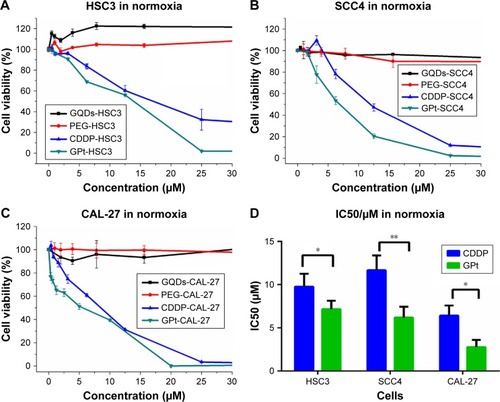
As shown in , both PEG and GQDs showed almost no cytotoxicity to HSC3 cells with the cell viability remaining at ~90% after 24 hours of incubation. In contrast, the nanoplatform constructed by the GQDs significantly enhanced the cytotoxicity of Pt to tumor cells. The IC50 value of free CDDP for HSC3 cells after 24 hours of incubation was 9.77±1.49 μM, whereas the IC50 value of GPt was only 7.15±0.99 μM and nearly 70% of tumor cells could be killed by 9.77 μM GPt after 24 hours (). The same trend was observed in the CAL-27 and SCC4 cell lines (). The IC50 values were 6.42±1.16 and 2.77±0.84 μM for CAL-27 cells, and 11.67±1.70 and 6.19±1.25 μM for SCC4 cells when treated with CDDP and GPt, respectively (). These results together demonstrated that GPt dramatically improved the anticancer efficacy in vitro.
In vitro antitumor effect of GPt in hypoxia condition
Hypoxyprobe was used to demonstrate the existence of a hypoxia microenvironment in a PDX model (). Antitumor effect of GPt was detected in vitro in hypoxia condition. The results proved that both HSC3 and SCC4 cells became resistant to free CDDP, resulting in a much higher IC50 value than that in normoxia condition (). Specifically, IC50 values of HSC3 and SCC4 treated with free CDDP changed from 9.77±1.49 and 11.67±0.41 μM in normoxia to 17.87±3.95 and 25.74±1.13 μM in hypoxia (). In contrast, the IC50 values of GPt did not change greatly between normoxia and hypoxia condition (ie, from 7.15±0.99 to 7.87±2.86 μM for HSC3 cells, and from 6.19±1.25 to 13.27±0.68 μM for SCC4 cells, respectively) (). Taken together, these results demonstrated that tumor hypoxia could lead to chemoresistance, and GPt was superior to free CDDP in its cytotoxic ability to kill OSCC cells in hypoxia.
Figure 5 CCK-8 assays of HSC3 (A) and SCC4 (B) cells treated with free CDDP and GPt. (C) IC50 values of HSC3 and SCC4 cells treated with CDDP or GPt under normoxia or hypoxia condition, respectively. *p<0.05; **p<0.01.
Abbreviations: CDDP, cisdiamminedichloroplatinum (II); CCK-8, cell counting kit; IC50, half maximal inhibitory concentration; GPt, polyethylene glycol-graphene quantum dots-Pt.
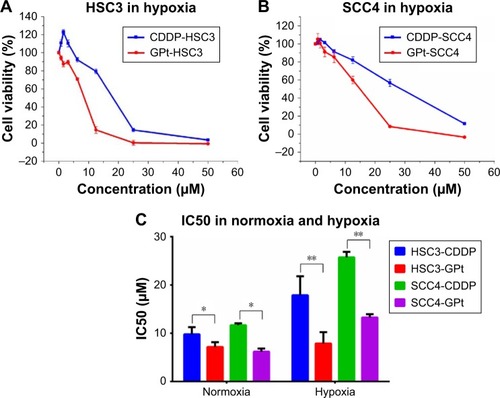
GPt enhances cell cycle arrest and promotes OSCC cells apoptosis
Destruction of the cell cycle is generally accepted as one of the possible mechanisms to kill cells.Citation4,Citation36 Consistent with this, after HSC3 cells were treated with the mean value of free CDDP and GPt IC50 in normoxia or hypoxia (8.46 μM for normoxia, and 12.84 μM for hypoxia), both free CDDP and GPt led to a significant but comparable cell cycle arrest at the S phase (74.65%±2.49% vs 68.39%±1.33%) in normoxia (, ). In contrast, cells remained at the G1 phase as a direct response to the effect of hypoxia. However, it was still observed that GPt had the ability to cause more cells arrest in S phase compared with CDDP and control groups (p<0.05), which partially explained the mechanism GPt applied to promote cell apoptosis ().
Figure 6 GPt enhances cell cycle arrest in OSCC cells. (A and E) Cell cycle changes of HSC3 cells treated with blank control, GQDs, free CDDP, and GPt under normoxia (A) or hypoxia (E) condition. (B–D) and (F–H) Cell cycle profiles of HSC3 cells treated with or without CDDP and GPt under normoxia (B–D) or hypoxia (F–H) condition for 24 hours. *p<0.05; **p<0.01.
Abbreviations: CDDP, cisdiamminedichloroplatinum (II); GQDs, graphene quantum dots; OSCC, oral squamous cell carcinoma; N, normoxia; H, hypoxia; GPt, polyethylene glycol-GQDs-Pt.

In addition to cell cycle arrest, GPt treatment promoted cell apoptosis compared with free CDDP (). In normoxia, GPt treatment resulted in over 70% and 50% cell apoptosis in HSC3 and SCC4 cells, respectively, whereas free CDDP induced only ~50% and 30% (). Similarly, in hypoxia, GPt treatment led to nearly 30% and 52.34% cell apoptosis in HSC3 and SCC4 cells, respectively, whereas free CDDP induced only ~9.02% and 32.3% ().
Figure 7 GPt promotes cell apoptosis in OSCC cells. Apoptotic rates of HSC3 and SCC4 cells treated with or without GQDs, free CDDP, or GPt (A–F). HSC3 cells were treated with 8.46 μM (normoxia) and 12.84 μM (hypoxia) of free CDDP and GPt, respectively, and SCC4 cells were treated with 8.93 μM (normoxia) and 19.71 μM (hypoxia) of free CDDP and GPt, respectively. *p<0.05.
Abbreviations: CDDP, cisdiamminedichloroplatinum (II); GQDs, graphene quantum dots; OSCC, oral squamous cell carcinoma; FITC, fluorescein isothiocyanate; PI, propidium iodide; N, normoxia; H, hypoxia; GPt, polyethylene glycol-GQDs-Pt.
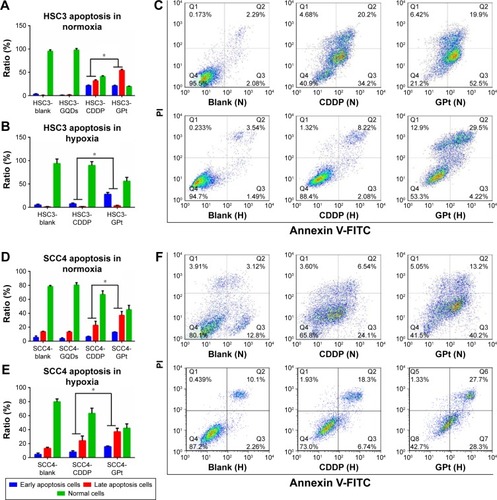
Taken together, these results demonstrate that GPt has a much more potent ability to induce OSCC cell cycle arrest and enhance cell apoptosis than free CDDP.
GPt increases Pt accumulation in cells and promotes Pt translocation into the nucleus
CDDP delivery systems based on nanocarriers such as micelles, nanoparticles, and graphene have been shown to have the ability to increase uptake of Pt and reduce side effects.Citation37 Hence, we studied Pt accumulation in GPt-treated cells using ICP-MS. As shown in and , the amount of Pt loaded on GQDs inside the cells was 3.13- to 5.02-fold greater than that for free CDDP inside the HSC3, SCC4, and CAL-27 cells in normoxia. A similar increase was also observed in hypoxia (, ). Thus, the GQD-based nanoplatform significantly enhanced the accumulation of Pt inside OSCC cells in both normoxia and hypoxia.
Figure 8 GQD enhances Pt accumulation in OSCC cells. Cellular accumulation of Pt with or without GQDs loaded in OSCC cells under normoxia (A) and hypoxia (B) conditions detected by ICP-MS. Cellular Pt was normalized to cellular protein ([Pt] ng/[protein] mg). **p<0.01; ***p<0.005.
Abbreviations: CDDP, cisdiamminedichloroplatinum (II); GQDs, graphene quantum dots; OSCC, oral squamous cell carcinoma; ICP-MS, inductively coupled plasma-mass spectrometry; GPt, polyethylene glycol-GQDs-Pt.
![Figure 8 GQD enhances Pt accumulation in OSCC cells. Cellular accumulation of Pt with or without GQDs loaded in OSCC cells under normoxia (A) and hypoxia (B) conditions detected by ICP-MS. Cellular Pt was normalized to cellular protein ([Pt] ng/[protein] mg). **p<0.01; ***p<0.005.Abbreviations: CDDP, cisdiamminedichloroplatinum (II); GQDs, graphene quantum dots; OSCC, oral squamous cell carcinoma; ICP-MS, inductively coupled plasma-mass spectrometry; GPt, polyethylene glycol-GQDs-Pt.](/cms/asset/f9ba8460-1671-46ec-886e-e7766313d48a/dijn_a_12193977_f0008_c.jpg)
To further visually identify the distribution of GQD-based nanosystems in cells, confocal laser scanning microscopy was used. Two hours after incubation, GPt was observed mostly in the cytoplasm (). Five to eight hours after incubation, GPt could be observed in the nucleus, but still mostly remained in the cytoplasm (). With the incubation time increased to 24 hours, the luminescence of GPt in the nucleus became much stronger and the cell morphology became more irregular (). This demonstrates that the GQDs can transfer Pt into the cell nucleus, suggesting that the GQDs are potential nucleus-targeted platforms for drug delivery. Pt-GQD-COOH was used as a control to demonstrate that the positive charge of GPt could enhance Pt accumulated in cells. As shown in , compared with GPt, the intensity of fluorescence inside the cells was weak. Variance between GPt and Pt-GQD-COOH suggested that the positive charge also played a role in increasing Pt cellular uptake.
Figure 9 Localization of the nanoplatform in cells. HSC3 was incubated with GPt (1 μM) for 2, 5, 8, and 24 hours, respectively (A–D). Cell membranes were stained in red with Dil dye, and the blue luminescence of GPt was excited at 405 nm under CLSM.
Abbreviations: CLSM, confocal laser scanning microscopy; GPt, polyethylene glycol-graphene quantum dots-Pt; Dil, 1,1′-Dioctadecyl-3,3,3′,3′-tetramethylindocarbocyanine perchlorate.
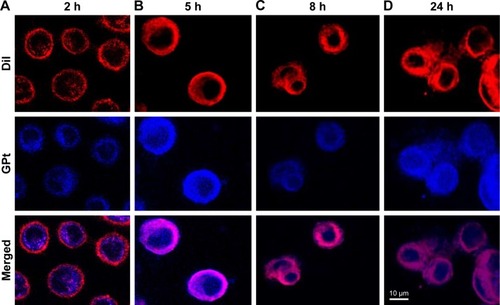
GPt inhibits tumor growth in vivo
Finally, the in vivo tumor growth inhibitory effect was investigated. As shown in , CDDP injection led to a slight decrease in animal weight compared with other groups, which was likely due to the systemic toxicity of CDDP (). Moreover, a significant growth inhibitory effect was observed in the GPt group (), suggesting that GPt exerted a more powerful anticancer effect than CDDP alone in vivo. HIF-1α expression was also detectable before and after treatment, suggesting that hypoxia did function as an important factor ( and ). Increased cell apoptosis stained with TUNEL was observed in the GPt group compared with the control and CDDP groups ().
Figure 10 GPt inhibits tumor growth in vivo. (A) Average body weight of mice in each experimental group. (B) Tumor volumes of mice after the injection of PBS, GQDs, CDDP, and GPt, respectively. (C) Distribution of Pt between tumor and different organs detected by ICP-MS. (D) The graphical display of HSC3 xenograft mice after being injected with PBS (I), GQDs (II), CDDP (III), and GPt (IV), respectively. (E) HE staining (100×), IHC staining of HIF-1α protein (100×), and TUNEL (400×) of tumor tissues in groups treated with PBS, GQDs, CDDP, and GPt. (F) Representative HE staining images of major organs including heart, liver, and kidney collected from HSC3 tumor bearing mice after treatment with PBS, GQDs, CDDP, and GPt, respectively. *p<0.05; **p<0.01; ***p<0.005.
Abbreviations: PBS, phosphate-buffered saline; HE, hematoxylin and eosin; IHC, immunohistochemistry; HIF-1α, hypoxia inducible factor-1α; ICP-MS, inductively coupled plasma-mass spectrometry; CDDP, cisdiamminedichloroplatinum (II); GQDs, graphene quantum dots; TUNEL, terminal deoxynucleotidyl transferase-mediated dUTP-biotin nick end labeling assay; GPt, polyethylene glycol-GQDs-Pt.
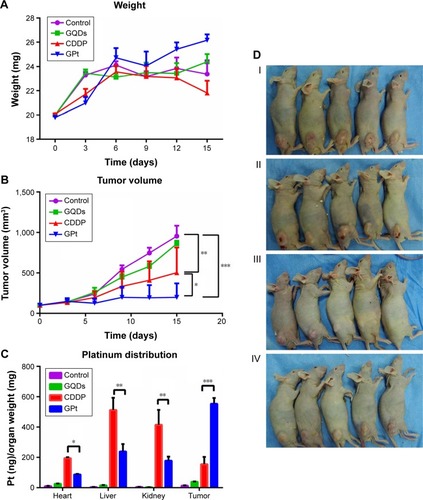

To investigate the systemic side effects, major organs of treated mice were collected. Livers in the CDDP group showed a sizable amount of inflammatory cell infiltration in the portal area, while there were tiny/small cells of denaturation observed in the GPt group (). Hearts exhibited no obvious differences among all groups; kidneys in the CDDP group had more swelling and vacuolation of proximal tubular epithelial cells, and inflammatory cell infiltration compared with the control and GPt groups (). Furthermore, Pt biodistribution in the major organs and tumor sites detected by ICP-MS analysis indicated a larger amount of Pt (553.62±38.09 ng [Pt]/mg [Tumor]) accumulated in tumor sites in the GPt group than the amount of Pt (154.70±48.19 ng [Pt]/mg [Tumor]) in the CDDP group (). Meanwhile, mice injected with CDDP showed a wide distribution of Pt in different organs such as kidney (414.97±98.24 ng [Pt]/mg [Kidney]) and liver (512.04±81.26 ng [Pt]/mg [Liver]), whereas much less Pt accumulation was observed in kidney (178.18±26.80 ng [Pt]/mg [Kidney]) and liver (239.16±48.50 ng [Pt]/mg [Liver]) in the GPt group (). These results together proved that GQDs could serve as an ideal candidate for cancer targeting drug carriers, which could significantly improve cancer therapeutic effects and reduce systemic side effects.
Discussion
As tumor recurrence and metastasis are commonly observed in OSCC patients, chemotherapy is still regarded as one of the most effective means. Unfortunately, many patients develop chemotherapy resistance due to various reasons.Citation38 Tumor hypoxia has been widely recognized as a major factor for chemoresistance.Citation11,Citation39 So far, many attempts have been made to enhance the efficacy of Pt by using adjuvants, drug combinations, and nanomedicine systems. For instance, survivin inhibitor YM155 and 3′,4′,5′,5,7-pentamethoxyflavone were shown to have the ability to sensitize cancer cells to CDDP.Citation18,Citation40 Previously, our group has also improved CDDP efficacy in hypoxia by the combined use of metformin to inhibit the activation of NF-κB/HIF-1α signaling.Citation12 However, the systemic toxicity of CDDP cannot be avoided.
Recently, the application of nanoparticles for drug delivery has attracted considerable attention. For instance, enhanced antitumor efficacy of CDDP was observed by co-loading CDDP and miRNA-375 into lipid nanoparticles.Citation40 However, studies on nanocarriers have rarely focused on hypoxia-induced chemoresistance. Herein, we developed a drug delivery nanosystem based on GQDs. Our results showed that GPt has the ability to promote Pt accumulation in tumor cells, reverse hypoxia-induced therapeutic resistance, and decrease the side effects of CDDP. Graphene-like materials are preeminent multifunctional materials in biomedicine because of their outstanding characteristics, including biosecurity, and excellent thermal properties.Citation21 Unfortunately, the large lateral size of GO and the interactions among GO layers could cause GO accretion.Citation18 To avoid accretion of GO, GQDs were used to ensure that the nanocomposite became more stable and thus could be stored for weeks before use. Additionally, the nanosystem developed in this study has good solubility and stability because of improved size and shape and its blue photoluminescence used for cell imaging.
The nanodrug system developed in this study exhibited great advantages in the treatment of OSCC compared with free CDDP. These results can be explained by the different cellular uptake mechanisms between GQDs and CDDP. It was demonstrated that GQDs were internalized via caveolae-mediated endocytosis, while free CDDP entered the cells via copper transportation systems.Citation41,Citation42 Our in vivo study confirmed that GPt could not only promote the accumulation of Pt in tumor sites, but also significantly decreased the distribution in the liver and kidney. The cytotoxic effect of GPt on the normal cell lines in normoxia and hypoxia was also detected, and it turned out that GPt actually killed normal cells in both conditions (). Therefore, the reason for GPt’s reduced systemic side effects in vivo is that GPt could gather more in tumor tissues via enhanced permeability and retention effect, not that GPt had no cytotoxic effect on normal cells.
Conclusion
GPt, a multifunctional nanocomposite based on GQDs, was successfully developed in our study. GPt could enhance cell cycle arrest in the S phase and lead to cell apoptosis. It could increase Pt accumulation inside cells in both normoxia and hypoxia. The performance of GPt in vivo showed that GPt could be an ideal candidate for anticancer therapy by improving pharmacokinetics of the drug for greater tumor accumulation and minimizing systemic toxicity. Therefore, our synthesized nano delivery system is expected to have wide clinical applications in future anticancer treatment.
Acknowledgments
This study was supported by the Jiangsu Provincial Key Research and Development Program (BE2017741), Nanjing Foundation for Development of Science and Technology (2017sc512031 and 201605042), and Jiangsu Provincial Natural Science Foundation (BK 20160051). In addition, we are grateful to Professor Zhou Ge from MD Anderson Cancer Center, Houston, TX, USA, for his help in English language review of the article.
Supplementary materials
Figure S1 Zeta potential distribution in the PBS of GQDs, GQDs-COOH, and GPt. The zeta potential value of (A) GQDs is −13.95±5.66 mV, (B) GQDs-COOH is −15.57±6.08 mV, and (C) GPt is +9.61±3.82 mV.
Abbreviations: PBS, phosphate-buffered saline; GQDs, graphene quantum dots; GPt, polyethylene glycol-GQDs-Pt.
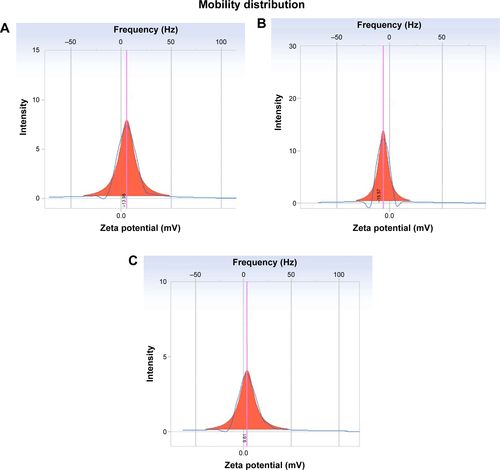
Figure S2 GO and GPt (from left to right) in acidic condition pH =5.
Abbreviations: GO, graphene oxide; GPt, polyethylene glycol-graphene quantum dots-Pt.
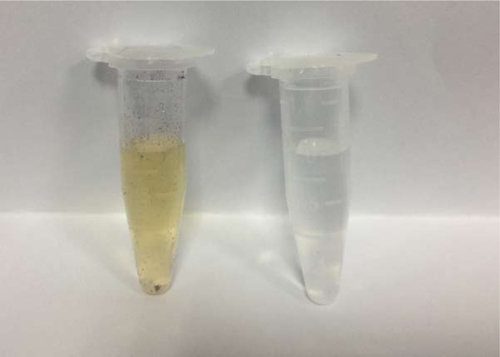
Figure S3 (A and B) Hypoxic areas exist in OSCC tumor tissues and hypoxia probe staining of tongue squamous cell carcinoma tissues. Cells stained in brown color are exposed to hypoxic field and fields stained in blue represent normal atmosphere. (C) HE staining of the PDX tumor specimen.
Abbreviations: OSCC, oral squamous cell carcinoma; PDX, patient-derived tongue tumor xenograft; HE, hematoxylin and eosin.
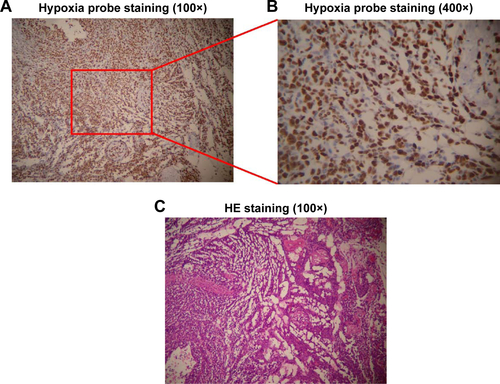
Figure S4 Localization of the nanoplatform in cells. Pt-GQDs-COOH was used as control. HSC3 was incubated with Pt-GQDs-COOH (1 μM) for 2, 5, 8, and 24 hours, respectively (A–D). Cell membranes were stained in red with Dil dye, and the blue luminescence of Pt-GQDs-COOH was excited at 405 nm under CLSM.
Abbreviations: GQDs, graphene quantum dots; CLSM, confocal laser scanning microscopy; Dil, 1,1′-Dioctadecyl-3,3,3′,3′-tetramethylindocarbocyanine perchlorate.
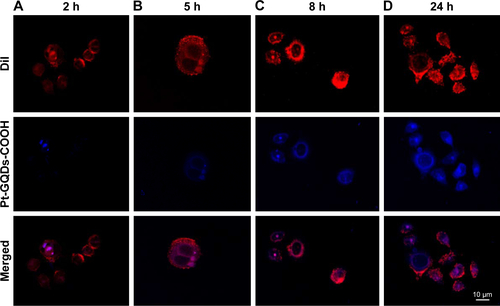
Figure S5 (A, C, and E) Representative images of HE staining of tumor tissues in various mice before injection (100×). (B, D, and F) Representative images of immunohistochemical staining of HIF-1α protein in tumor tissue in various mice before treatment (400×).
Abbreviations: HE, hematoxylin and eosin; HIF-1α, hypoxia inducible factor-1α.
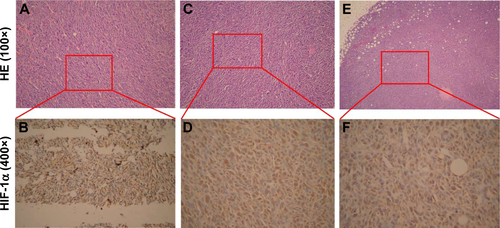
Disclosure
The authors report no conflicts of interest in this work.
References
- LambertRSauvagetCde Camargo CancelaMSankaranarayananREpidemiology of cancer from the oral cavity and oropharynxEur J Gastroenterol Hepatol201123863364121654320
- KimpleAJWelchCMZevallosJPPatelSNOral cavity squamous cell carcinoma – an overviewOral Health Dent Manag201413387788225284574
- PfisterDGAngKBrocksteinBNCCN practice guidelines for head and neck cancersOncology20001411A16319411195409
- LangerTam Zehnhoff-DinnesenARadtkeSMeitertJZolkOUnderstanding platinum-induced ototoxicityTrends Pharmacol Sci201334845846923769626
- FerreiraJAPeixotoANevesMMechanisms of cisplatin resistance and targeting of cancer stem cells: adding glycosylation to the equationDrug Resist Updat201624345426830314
- SenthebaneDARoweAThomfordNEThe role of tumor microenvironment in chemoresistance: to survive, keep your enemies closerInt J Mol Sci2017187pii:E1586
- CastellsMThibaultBDelordJPCoudercBImplication of tumor microenvironment in chemoresistance: tumor-associated stromal cells protect tumor cells from cell deathInt J Mol Sci20121389545957122949815
- ColemanCNHypoxia in tumors: a paradigm for the approach to biochemical and physiologic heterogeneityJ Natl Cancer Inst19888053103173282077
- FingerECGiacciaAJHypoxia, inflammation, and the tumor microenvironment in metastatic diseaseCancer Metastasis Rev201029228529320393783
- WilsonWRHayMPTargeting hypoxia in cancer therapyNat Rev Cancer201111639341021606941
- HanSXuWWangZCrosstalk between the HIF-1 and Toll-like receptor/nuclear factor-κB pathways in the oral squamous cell carcinoma microenvironmentOncotarget2016725377733778927191981
- QiXXuWXieJMetformin sensitizes the response of oral squamous cell carcinoma to cisplatin treatment through inhibition of NF-κB/HIF-1α signal axisSci Rep201663578827762347
- AlshememryAKEl-TokhySSUnsworthLDUsing properties of tumor microenvironments for controlling local, on-demand delivery from biopolymer-based nanocarriersCurr Pharm Des Epub2017521
- DamaghiMGilliesRPhenotypic changes of acid-adapted cancer cells push them toward aggressiveness in their evolution in the tumor microenvironmentCell Cycle201716191739174327635863
- KostkaLŠubrVLagaRNanotherapeutics shielded with a pH responsive polymeric layerPhysiol Res201564Suppl 1S29S4026447593
- ZhouTXiaoCFanJA nanogel of on-site tunable pH-response for efficient anticancer drug deliveryActa Biomater2013914546455722906624
- ChoyCJLeyCRDavisALSecond-generation tunable pH-sensitive phosphoramidate-based linkers for controlled releaseBioconjug Chem20162792206221327562353
- LiJLyvZLiYA theranostic prodrug delivery system based on Pt(IV) conjugated nano-graphene oxide with synergistic effect to enhance the therapeutic efficacy of Pt drugBiomaterials201551122125770993
- WangYWangKZhaoJMultifunctional mesoporous silica-coated graphene nanosheet used for chemo-photothermal synergistic targeted therapy of gliomaJ Am Chem Soc2013135124799480423495667
- OhSSLeeBFLeibfarthFASynthetic aptamer-polymer hybrid constructs for programmed drug delivery into specific target cellsJ Am Chem Soc201413642150101501525290917
- TianFLyuJShiJYangMGraphene and graphene-like two-denominational materials based fluorescence resonance energy transfer (FRET) assays for biological applicationsBiosens Bioelectron201689Pt 112313527342369
- SuXChanCShiJA graphene quantum dot@Fe3O4@SiO2 based nanoprobe for drug delivery sensing and dual-modal fluorescence and MRI imaging in cancer cellsBiosens Bioelectron20169248949527839733
- ChenHWangZZongSA graphene quantum dot-based FRET system for nuclear-targeted and real-time monitoring of drug deliveryNanoscale2015737154771548626346491
- MarkovicZMRisticBZArsikinKMGraphene quantum dots as autophagy-inducing photodynamic agentsBiomaterials201233297084709222795854
- SuryawanshiABiswalMMhamaneDLarge scale synthesis of graphene quantum dots (GQDs) from waste biomass and their use as an efficient and selective photoluminescence on–off–on probe for Ag(+) ionsNanoscale2014620116641167025162814
- CiobotaruCCDamianCMMateiEIovuHCovalent functionalization of graphene oxide with cisplatinMater Plast20145117580
- HwangDWKimHYLiFIn vivo visualization of endogenous miR-21 using hyaluronic acid-coated graphene oxide for targeted cancer therapyBiomaterials201712114415428088076
- DongYChenCZhengXOne-step and high yield simultaneous preparation of single- and multi-layer graphene quantum dots from CX-72 carbon blackJ Mater Chem2012221887648766
- ZhangWGuoZHuangDLiuZGuoXZhongHSynergistic effect of chemo-photothermal therapy using PEGylated graphene oxideBiomaterials201132338555856121839507
- TianLPeiXZengYFunctionalized nanoscale graphene oxide for high efficient drug delivery of cisplatinJ Nanopart Res201416112709
- AnilanmertBYalcinGAriözFDölenEThe spectrophotometric determination of cisplatin in urine, using o-phenylenediamine as derivatizing agentAnal Lett2001341113123
- RaghavanRMulliganJALow-level (PPB) determination of cisplatin in cleaning validation (rinse water) samples. I. An atomic absorption spectrophotometric methodDrug Dev Ind Pharm200026442342810769784
- WuWShenJGaiZHongKBanerjeePZhouSMulti-functional core-shell hybrid nanogels for pH-dependent magnetic manipulation, fluorescent pH-sensing, and drug deliveryBiomaterials201132369876988721944827
- LiuZRobinsonJTSunXDaiHPEGylated nano-graphene oxide for delivery of water insoluble cancer drugsJ Am Chem Soc200813033108761087718661992
- JamiesonERLippardSJStructure, recognition, and processing of cisplatin-DNA adductsChem Rev19999992467249811749487
- ChaneySGCampbellSLBassettEWuYRecognition and processing of cisplatin- and oxaliplatin-DNA adductsCrit Rev Oncol Hematol200553131115607931
- PanYSahooNGLiLThe application of graphene oxide in drug deliveryExpert Opin Drug Deliv20129111365137623005029
- YuZWZhongLPJiTZhangPChenWTZhangCPMicroRNAs contribute to the chemoresistance of cisplatin in tongue squamous cell carcinoma linesOral Oncol201046431732220219416
- SelvendiranKBrataszAMKuppusamyMLTaziMFRiveraBKKuppusamyPHypoxia induces chemoresistance in ovarian cancer cells by activation of signal transducer and activator of transcription 3Int J Cancer200912592198220419623660
- YangTZhaoPRongZAnti-tumor efficiency of lipid-coated cisplatin nanoparticles co-loaded with microRNA-375Theranostics20166114215426722380
- WuCWangCHanTZhouXGuoSZhangJInsight into the cellular internalization and cytotoxicity of graphene quantum dotsAdv Healthc Mater20132121613161923703800
- SafaeiRHowellSBRegulation of the cellular pharmacology and cytotoxicity of cisplatin by copper transportersTeicherBACancer Drug ResistanceNew YorkHumana Press2006309327

